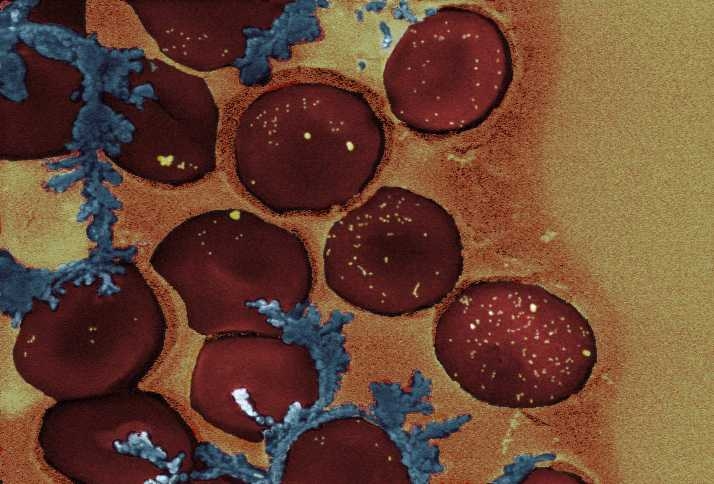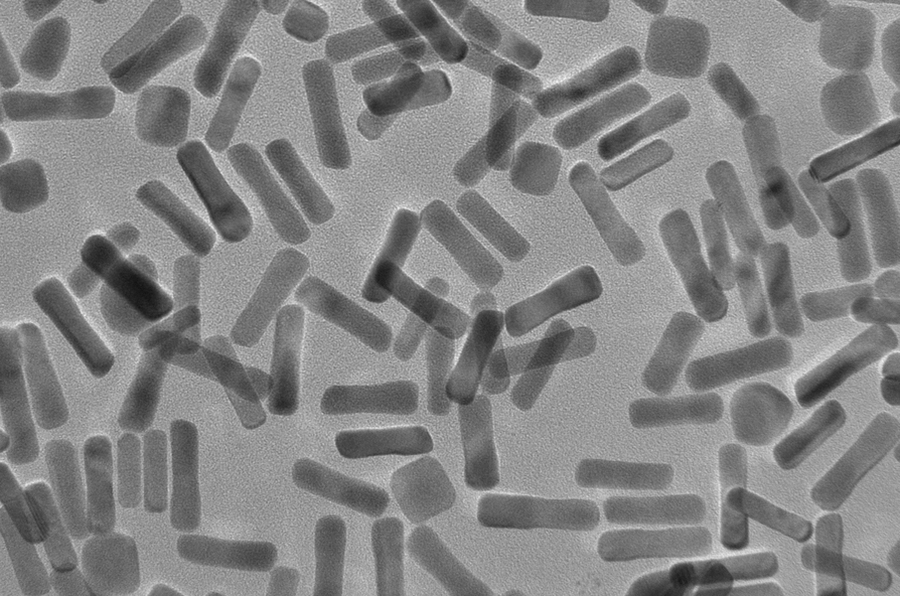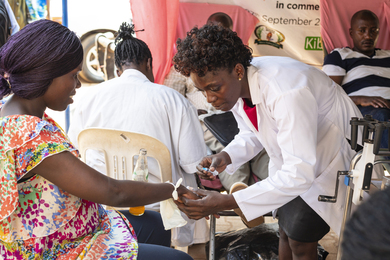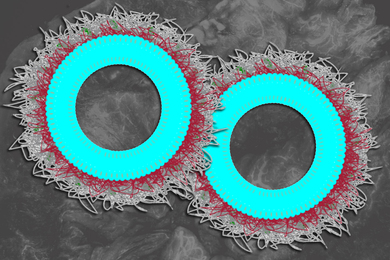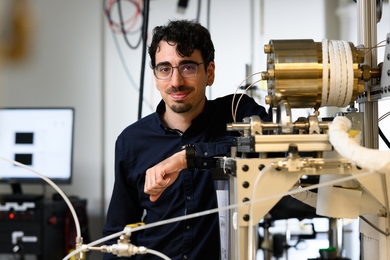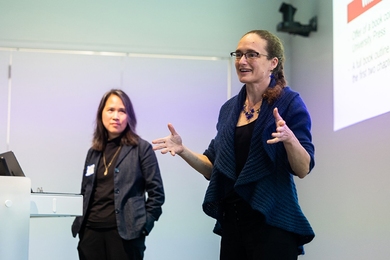Using gold nanoparticles, MIT researchers have devised a new way to turn blood clotting on and off. The particles, which are controlled by infrared laser light, could help doctors control blood clotting in patients undergoing surgery, or promote wound healing.
Currently, the only way doctors can manage blood clotting is by administering blood thinners such as heparin. This reduces clotting, but there is no way to counteract the effects of heparin and other blood thinners.
“It’s like you have a light bulb, and you can turn it on with the switch just fine, but you can’t turn it off. You have to wait for it to burn out,” says Kimberly Hamad-Schifferli, a technical staff member at MIT Lincoln Laboratory and senior author of a paper describing the new particles, which can turn blood clotting off and then restore it when necessary.
Lead author of the paper, which is appearing in the July 24 issue of the journal PLoS One, is Helena de Puig, an MIT graduate student in mechanical engineering. Other authors are Anna Cifuentes Rius, a visiting student from Ramon Llull University in Spain, and MIT senior Dorma Flemister.
Blood clotting is produced by a long cascade of protein interactions, culminating in the formation of fibrin, a fibrous protein that seals wounds. Heparin and other blood thinners interfere with this process by targeting several of the reactions that occur during the blood-clotting cascade. A better solution, Hamad-Schifferli says, would be an agent that targets only the last step — the conversion of fibrinogen to fibrin, a reaction mediated by an enzyme called thrombin.
Several years ago, scientists discovered that DNA with a specific sequence inhibits thrombin by blocking the site where it would typically bind fibrinogen. The complementary DNA sequence can shut off the inhibition by binding to the original DNA strand and preventing it from attaching to thrombin.
Hamad-Schifferli and her colleagues had previously demonstrated that gold nanorods can be designed to release drugs or other compounds when activated with infrared light. The size of the nanorod determines the wavelength of light that will activate it, so two rods of different lengths can carry different payloads and be controlled separately.
To manipulate the blood-clotting cascade, Hamad-Schifferli decided to load a smaller gold nanorod (35 nanometers long) with the DNA thrombin inhibitor and a larger particle (60 nanometers long) with the complementary DNA strand. At first, they tried to get the DNA to chemically bond to the gold nanoparticles. However, they found they couldn’t load enough DNA onto each particle to make this process effective.
Then, Hamad-Schifferli says, “We realized we could use a bad side effect of nanoparticle biology to our advantage.” That is, the particles tend to attract a halo of proteins that bind to gold, making them sticky. In previous studies, she has shown that this large cloud of proteins can be used to hold a drug payload.
“If you do that, you can get way more drug on the nanorod than you normally would if you had to chemically link them together,” Hamad-Schifferli says. By soaking the nanorods in a solution of human serum protein and the DNA molecules, the researchers were able to attach six times more DNA than through chemical bonding.
When the gold nanorods are exposed to the correct wavelength of infrared light, the electrons within the gold become very excited and generate so much heat that they melt slightly, taking on a more spherical shape and releasing their DNA payload.
The researchers tested the nanoparticles using blood donated to hospitals, and found that the particles successfully turned blood clotting on and off in all of the samples tested.
“It’s really a fascinating idea that you can control blood clotting not just one way but by having two different optical antennae to create two-way control,” says Luke Lee, a professor of bioengineering at the University of California at Berkeley who was not part of the research team. “It’s an innovative and creative way to interface with biological systems.”
For the particles to be practical for use in patients, they would need to be targeted to the site of injury, which the researchers are now working on doing. Once they reached the site, they would need to be within a few millimeters of the skin surface for the infrared light shone on the skin to reach them.
The researchers are also working on modifying the system so the particles can be activated using a continuous wave laser, which is smaller and less powerful than the pulsed femtosecond laser they are currently using.
The research was funded by the National Science Foundation.
Currently, the only way doctors can manage blood clotting is by administering blood thinners such as heparin. This reduces clotting, but there is no way to counteract the effects of heparin and other blood thinners.
“It’s like you have a light bulb, and you can turn it on with the switch just fine, but you can’t turn it off. You have to wait for it to burn out,” says Kimberly Hamad-Schifferli, a technical staff member at MIT Lincoln Laboratory and senior author of a paper describing the new particles, which can turn blood clotting off and then restore it when necessary.
Lead author of the paper, which is appearing in the July 24 issue of the journal PLoS One, is Helena de Puig, an MIT graduate student in mechanical engineering. Other authors are Anna Cifuentes Rius, a visiting student from Ramon Llull University in Spain, and MIT senior Dorma Flemister.
Blood clotting is produced by a long cascade of protein interactions, culminating in the formation of fibrin, a fibrous protein that seals wounds. Heparin and other blood thinners interfere with this process by targeting several of the reactions that occur during the blood-clotting cascade. A better solution, Hamad-Schifferli says, would be an agent that targets only the last step — the conversion of fibrinogen to fibrin, a reaction mediated by an enzyme called thrombin.
Several years ago, scientists discovered that DNA with a specific sequence inhibits thrombin by blocking the site where it would typically bind fibrinogen. The complementary DNA sequence can shut off the inhibition by binding to the original DNA strand and preventing it from attaching to thrombin.
Hamad-Schifferli and her colleagues had previously demonstrated that gold nanorods can be designed to release drugs or other compounds when activated with infrared light. The size of the nanorod determines the wavelength of light that will activate it, so two rods of different lengths can carry different payloads and be controlled separately.
To manipulate the blood-clotting cascade, Hamad-Schifferli decided to load a smaller gold nanorod (35 nanometers long) with the DNA thrombin inhibitor and a larger particle (60 nanometers long) with the complementary DNA strand. At first, they tried to get the DNA to chemically bond to the gold nanoparticles. However, they found they couldn’t load enough DNA onto each particle to make this process effective.
Then, Hamad-Schifferli says, “We realized we could use a bad side effect of nanoparticle biology to our advantage.” That is, the particles tend to attract a halo of proteins that bind to gold, making them sticky. In previous studies, she has shown that this large cloud of proteins can be used to hold a drug payload.
“If you do that, you can get way more drug on the nanorod than you normally would if you had to chemically link them together,” Hamad-Schifferli says. By soaking the nanorods in a solution of human serum protein and the DNA molecules, the researchers were able to attach six times more DNA than through chemical bonding.
When the gold nanorods are exposed to the correct wavelength of infrared light, the electrons within the gold become very excited and generate so much heat that they melt slightly, taking on a more spherical shape and releasing their DNA payload.
The researchers tested the nanoparticles using blood donated to hospitals, and found that the particles successfully turned blood clotting on and off in all of the samples tested.
“It’s really a fascinating idea that you can control blood clotting not just one way but by having two different optical antennae to create two-way control,” says Luke Lee, a professor of bioengineering at the University of California at Berkeley who was not part of the research team. “It’s an innovative and creative way to interface with biological systems.”
For the particles to be practical for use in patients, they would need to be targeted to the site of injury, which the researchers are now working on doing. Once they reached the site, they would need to be within a few millimeters of the skin surface for the infrared light shone on the skin to reach them.
The researchers are also working on modifying the system so the particles can be activated using a continuous wave laser, which is smaller and less powerful than the pulsed femtosecond laser they are currently using.
The research was funded by the National Science Foundation.
